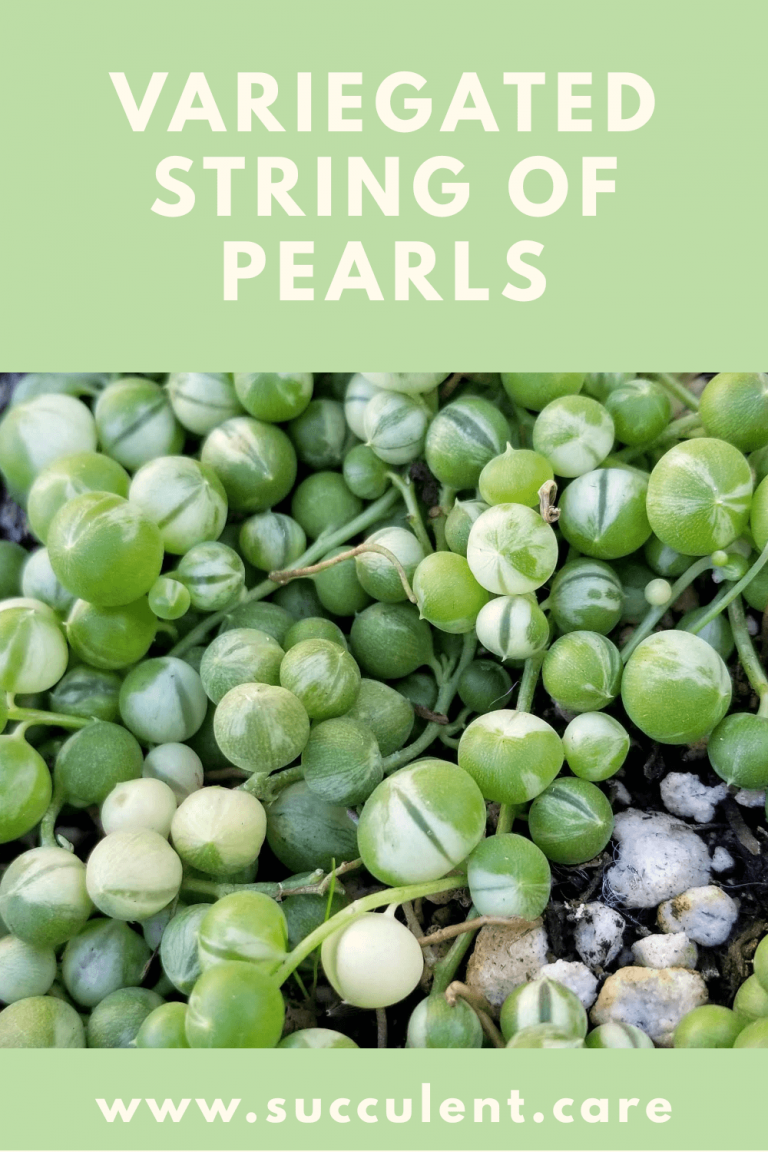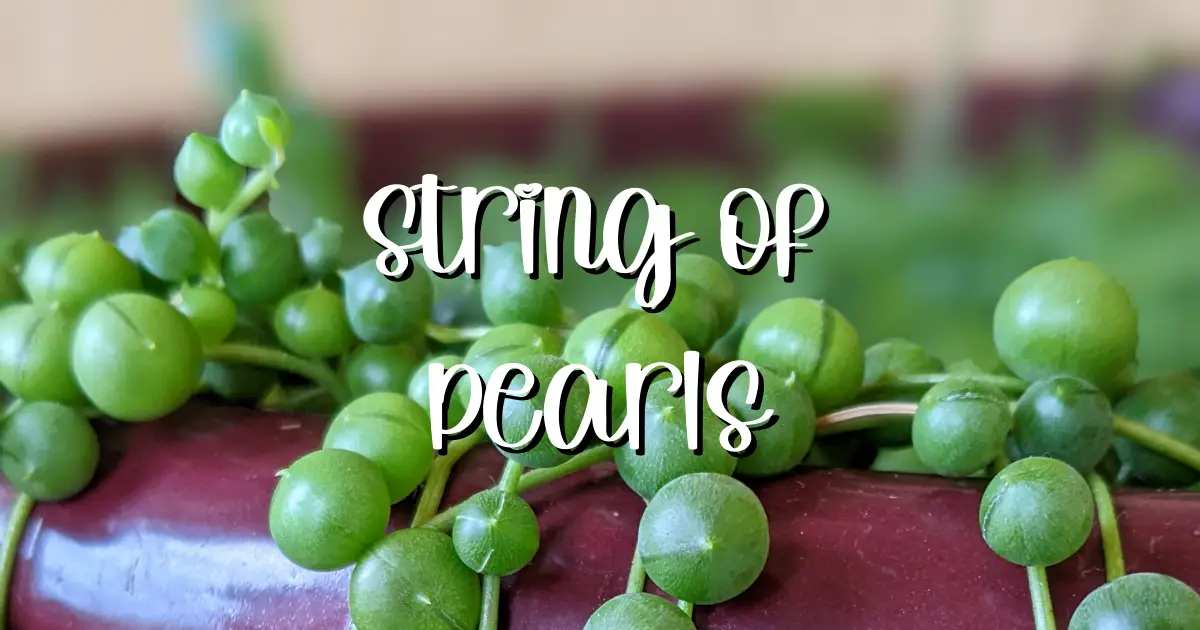Senecio rowleyanus, also known as ‘String of Pearls’, is an unusual succulent with nearly spherical leaves from South Africa. Named after British botanist Gordon Rowley, this plant is a must-have for any succulent enthusiast. Not only is it unique and interesting, but it is also easy to care for. In this post, we’ll cover everything you need to know about growing and maintaining this beautiful plant.
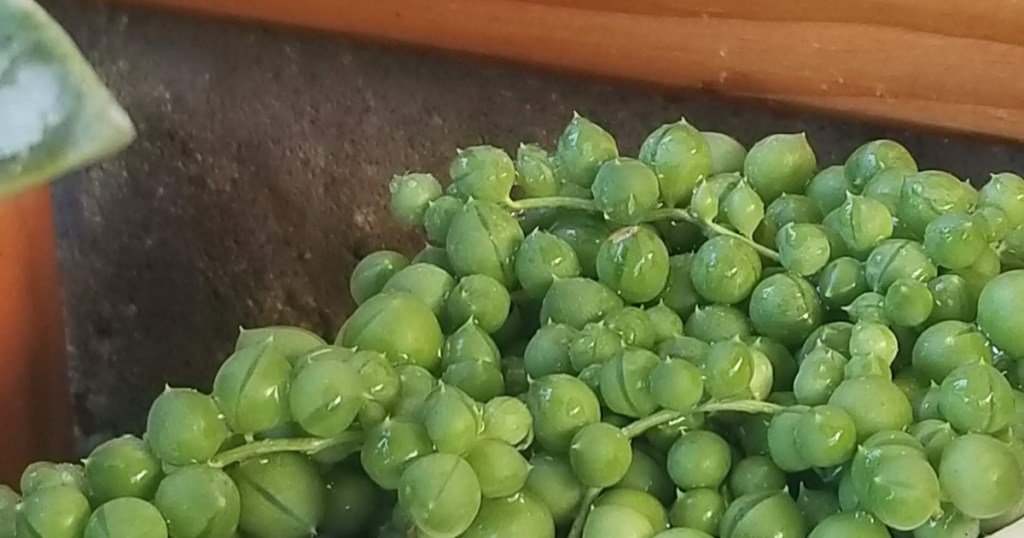
Description of Senecio rowleyanus ‘String of Pearls’
‘String of Pearls’, is a unique succulent plant with small, spherical leaves that resemble tiny peas. The leaves grow on long, thin stems that trail and cascade down from the plant, reaching up to three feet in length. One of the plant’s unique features is its ability to grow from surface roots, forming dense mats of foliage. This trailing succulent is a popular choice for hanging baskets and can add an interesting touch to any room. When grown in a hanging basket, the stems will cascade gracefully over the side, creating an elegant display.
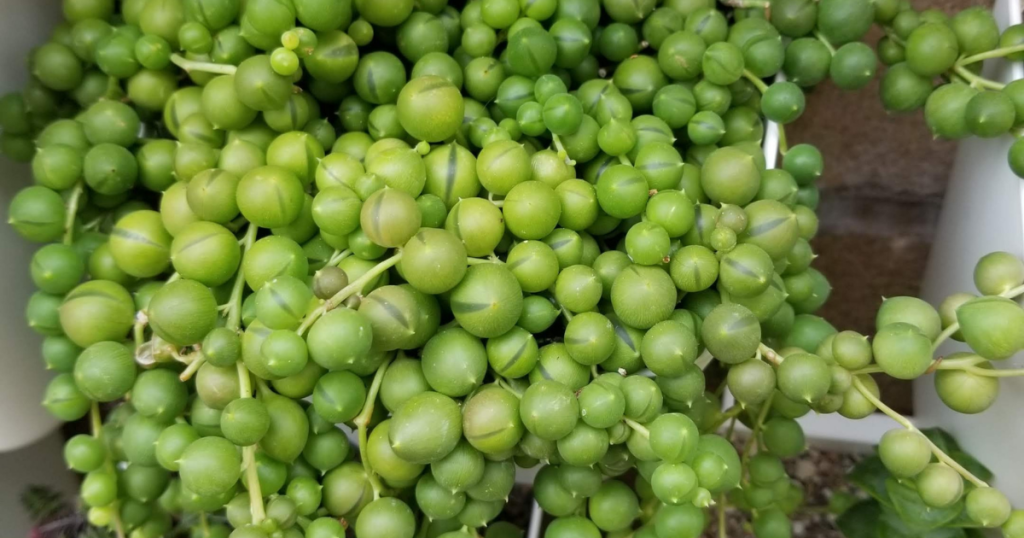
Senecio rowleyanus ‘String of Pearls’ adapts well to its environment, the round shape of the leaves minimizes the surface area exposed to dry desert air and therefore reduces evaporative water loss but also reduces the surface area where photosynthesis can occur compared to a normal thin, flat leaf. The stripe of darker, translucent tissue on the side of the leaf is called an “epidermal window” which allows light to enter the interior of the leaf, effectively increasing the area available for photosynthesis.
You might also like: 10 Cactus and Succulent Adaptations: How These Incredible Plants Have Adapted to Survive in Extreme Environments
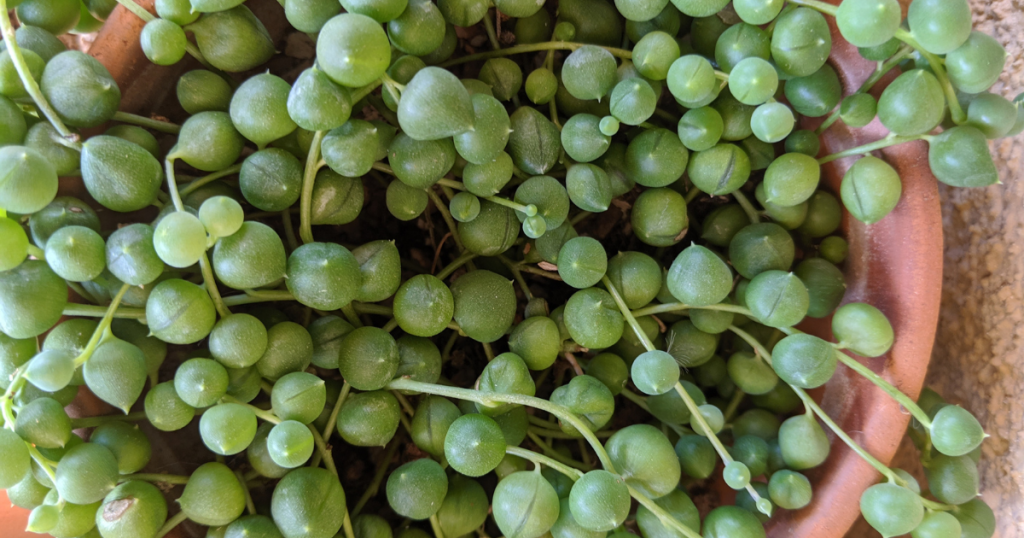
Senecio rowleyanus ‘String of Pearls’ blooms in summer, producing small, fragrant flowers that are not showy but have a sweet and spicy, cinnamon-like scent.
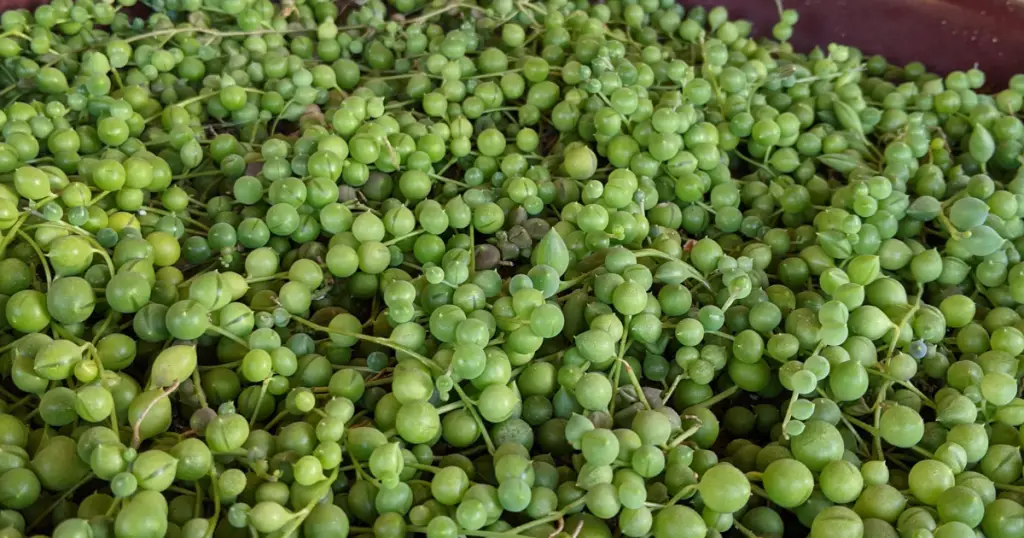
‘String of Pearls’ Care and Maintenance Made Easy
Bright, Indirect Light
Senecio rowleyanus ‘String of Pearls’ is a succulent that grows best in bright, indirect light. This means placing the plant near a window where it can receive bright, filtered sunlight, or under grow lights if natural light is not available. However, direct sunlight can burn the plant, so it is important to avoid placing it in direct sunlight, especially during the hottest part of the day.
You might also like: How Much Light Do Succulents Need? A Comprehensive Guide in 12 Parts
While the plant can tolerate some shade, too little light can be detrimental to its growth. When the plant doesn’t receive enough light, the leaves can start to turn yellow and fall off. This is because the plant needs light to photosynthesize and produce energy to grow. Therefore, it is important to find a balance between too much light and too little light, ensuring that the plant is receiving enough light to thrive without being exposed to too much direct sunlight.
You might also like: Sunburnt Succulents
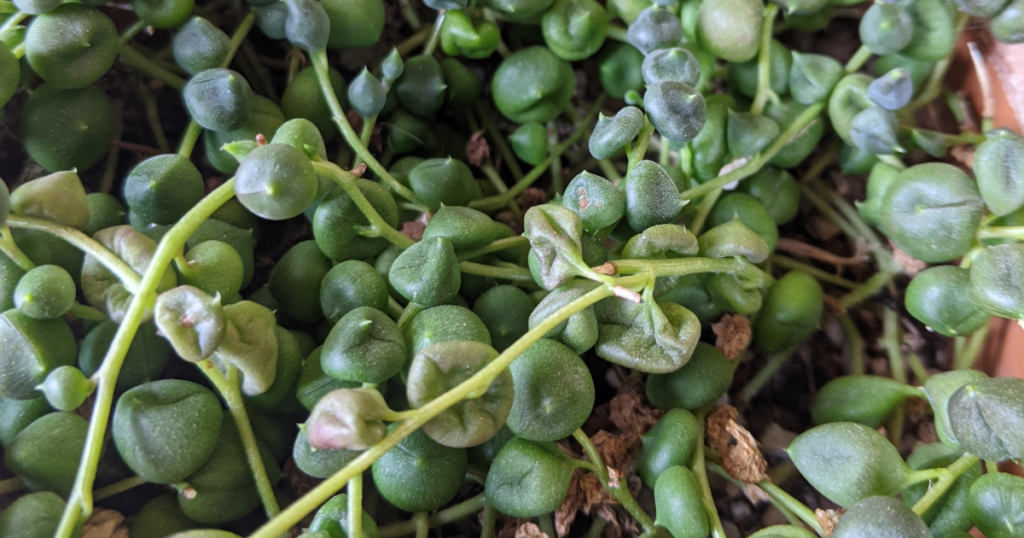
Watering
Watering is a crucial aspect of caring for Senecio rowleyanus ‘String of Pearls’. The plant is native to regions with arid climates, and therefore it is essential to avoid overwatering. The soil should be allowed to dry out between waterings, as the plant is susceptible to root rot caused by overwatering.
You might also like: How and When to Water Succulents So They Don’t Die (2023 Update)
The frequency of watering will depend on the climate and humidity of the area where the plant is grown. In general, the plant should be watered when the soil is completely dry. A good way to check whether the plant needs water is by feeling the soil with your fingers. If the soil feels dry, it is time to water the plant. It is recommended to water the plant from the bottom to prevent water from getting on the leaves, which can cause rot.
You might also like: Root Rot in Succulents: How to Identify and Treat the Problem
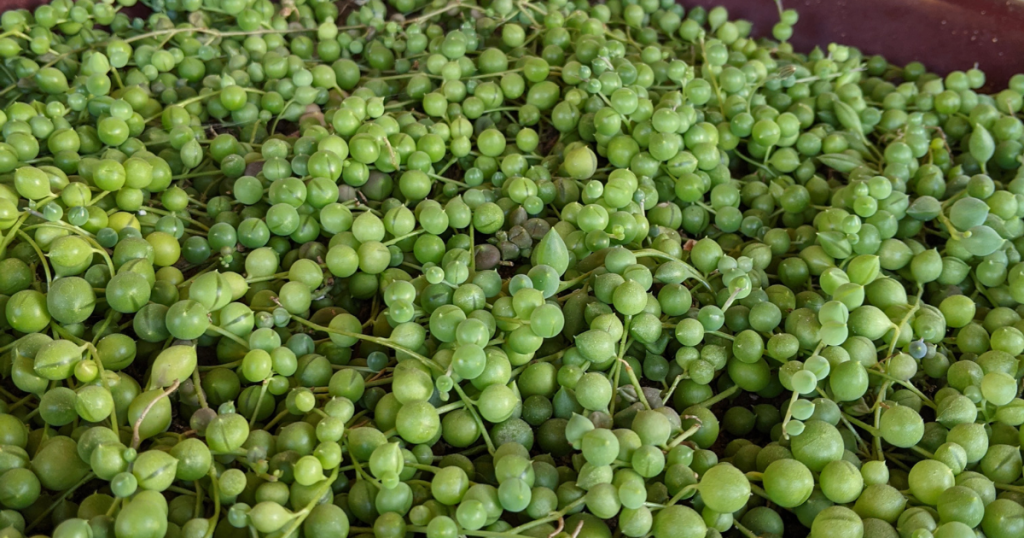
Soil
The right soil type is important for the healthy growth of Senecio rowleyanus ‘String of Pearls’. The plant prefers a well-draining soil mix that allows water to pass through quickly. A cactus mix, which is specifically formulated for succulent plants, is an excellent choice for growing this plant. Alternatively, a standard potting soil mixed with sand or grit can also work well to improve drainage. The sand or grit will help prevent water from pooling at the bottom of the pot, which can lead to root rot.
You might also like: Succulent Soil: Ultimate Guide and 4 DIY Recipes to Keep Your Succulents Happy and Healthy
It’s important to avoid using heavy, clay-based soils or those that retain too much moisture as they can cause the roots to become waterlogged and eventually rot. When repotting the plant, choose a pot that has drainage holes to allow excess water to escape.
You might also like: Drainage Hole at the Bottom of The Pot: Do Succulents Need Them? The Answer Might Completely Shock You!
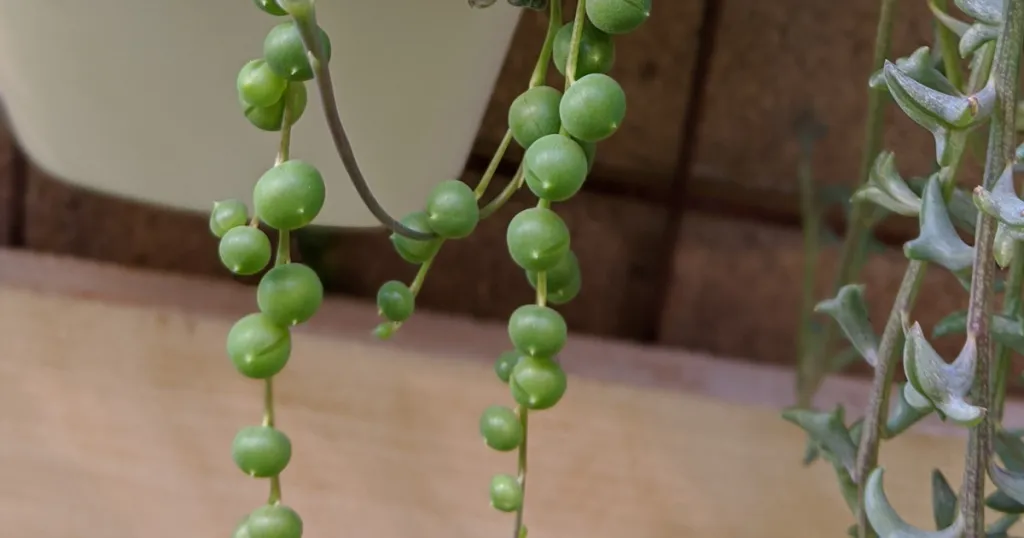
Fertilization
While Senecio rowleyanus ‘String of Pearls’ does not require regular fertilization, a balanced, water-soluble fertilizer can be applied during the growing season to promote healthy growth. However, it is important to dilute the fertilizer to half the recommended strength to avoid over-fertilization, which can damage the roots and cause the leaves to fall off.
You might also like: Succulent Fertilizer: The Ultimate Guide to Healthy Succulents + 8 DIY Fertilizer Recipes
Fertilization can be done once every two weeks to once a month, depending on the strength of the fertilizer used. It is best to avoid fertilizing the plant during the winter months when it is dormant.
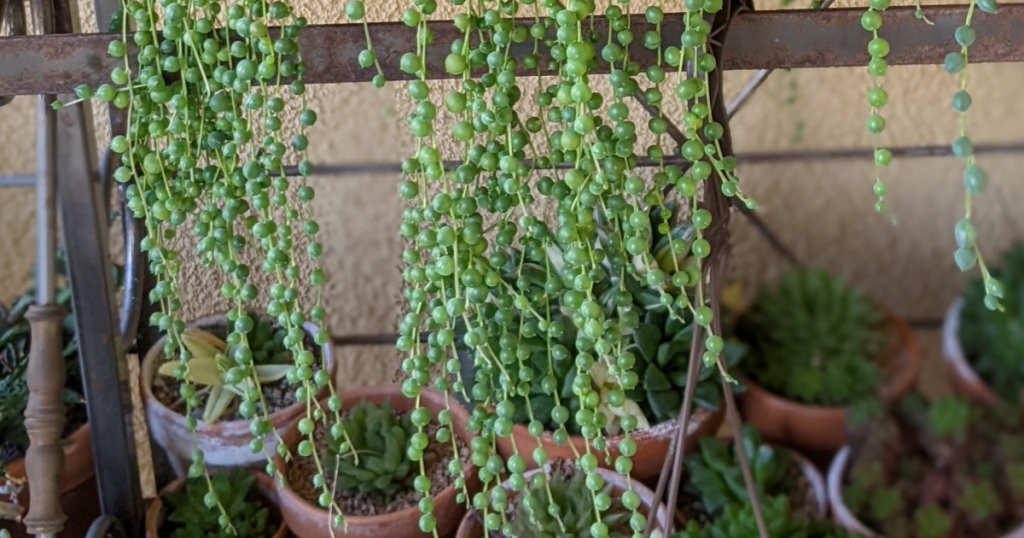
Senecio rowleyanus ‘String of Pearls’ Pests and Diseases
Senecio rowleyanus ‘String of Pearls’ is generally a hardy and low-maintenance plant, but it can still be susceptible to pests and diseases. Some common issues to watch out for include mealybugs, spider mites, and scale insects. These pests can cause damage to the plant by sucking the sap out of the leaves, which can cause wilting and yellowing of the leaves. If you notice any signs of infestation, you should act quickly to prevent the problem from getting worse.
You might also like: 12 Succulent Pests and Diseases: Identification, Treatment, and Easy Prevention of Mealybugs, Thrips and More
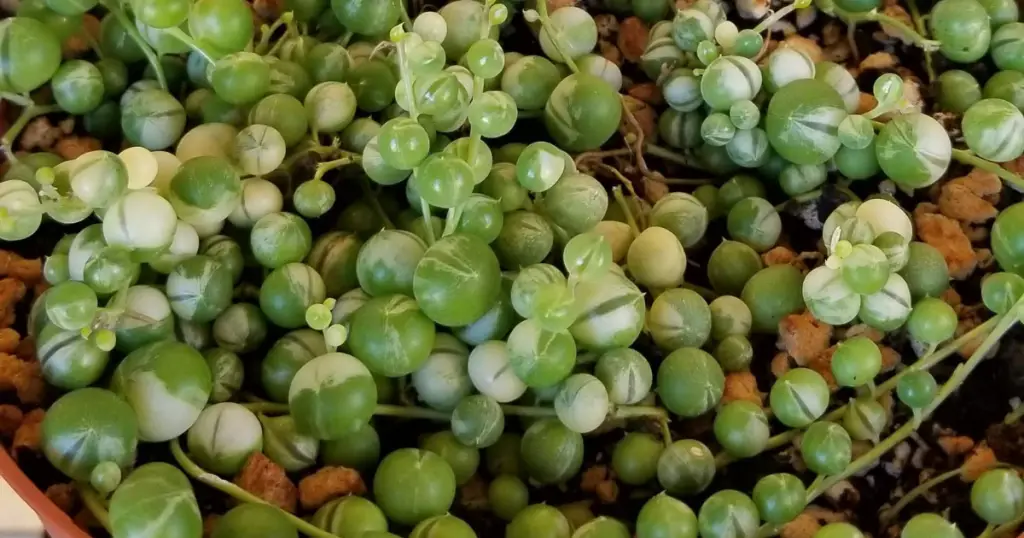
In addition to pests, Senecio rowleyanus ‘String of Pearls’ can also be susceptible to root rot or fungus gnats if overwatered or if the soil does not drain properly. This can be avoided by ensuring the soil is well-draining and allowing it to dry out between waterings. If you notice any signs of root rot, such as soft, mushy roots or a foul odor, it is important to act quickly to save the plant. Remove any affected roots and allow the soil to dry out completely before resuming watering.
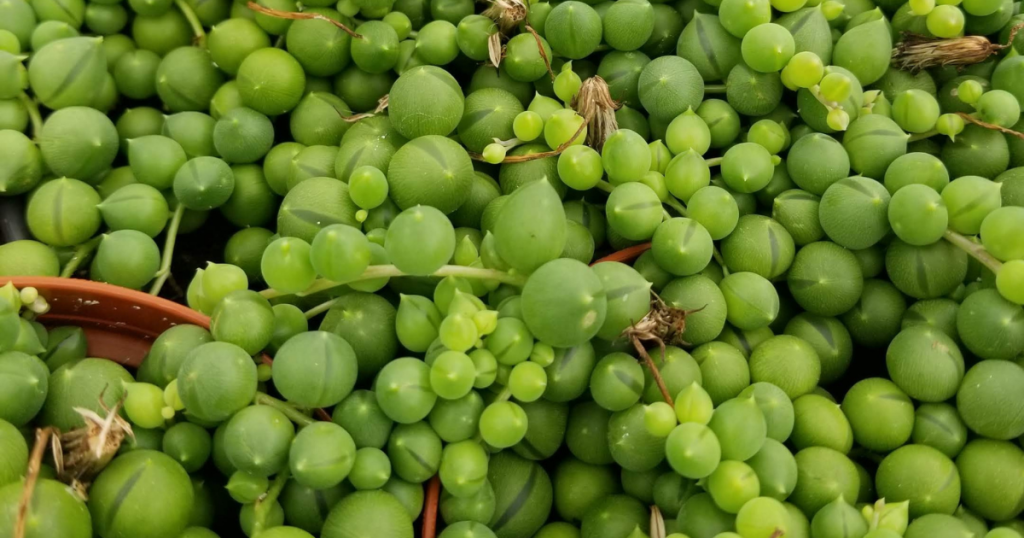
One way to treat an infestation of pests is by using a solution of water and mild dish soap. Simply mix a few drops of dish soap into a spray bottle filled with water and spray the plant, making sure to cover all the affected areas. This will suffocate the insects and prevent them from spreading. Another option is to use a specific insecticide that is formulated for use on succulent plants. Be sure to follow the instructions carefully and use only as directed.
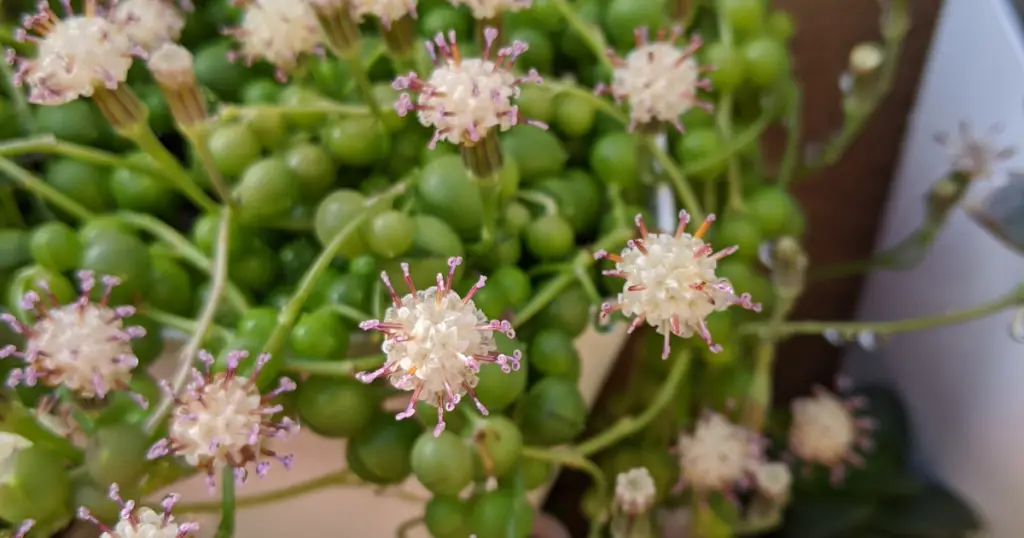
How to Propagate String of Pearls
Propagating Senecio rowleyanus ‘String of Pearls’ is a simple and rewarding process that can help you expand your collection or share the plant with friends. Here’s a guide on how to propagate string of pearls.
You might also like: Propagating Succulents 4 Ways: The Best Guide Ever
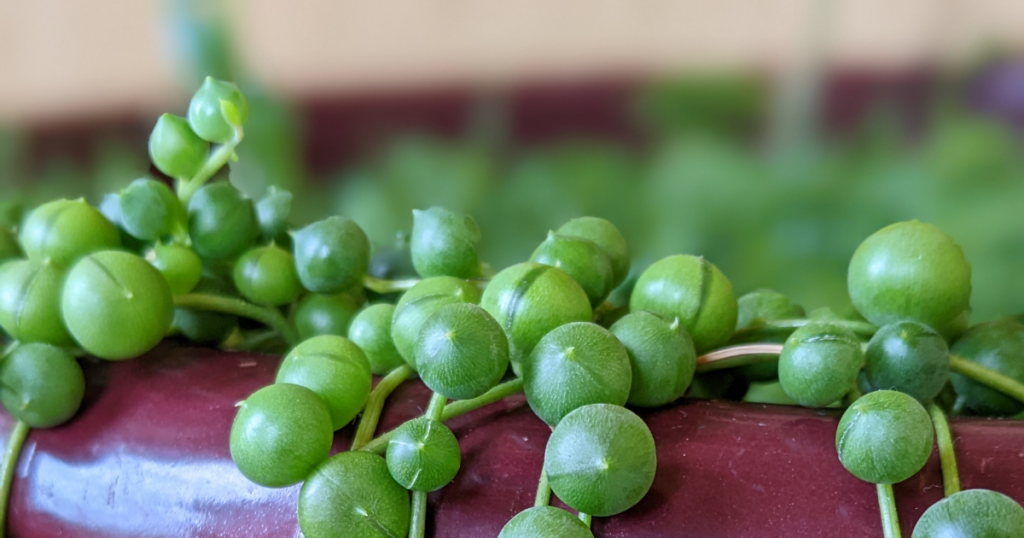
Propagating by Stem Cuttings
The most common method of propagating Senecio rowleyanus ‘String of Pearls’ is through stem cuttings. Here’s how to do it:
Materials:
A healthy string of pearls plant
Pruning shears
Potting mix
Small pots
Water
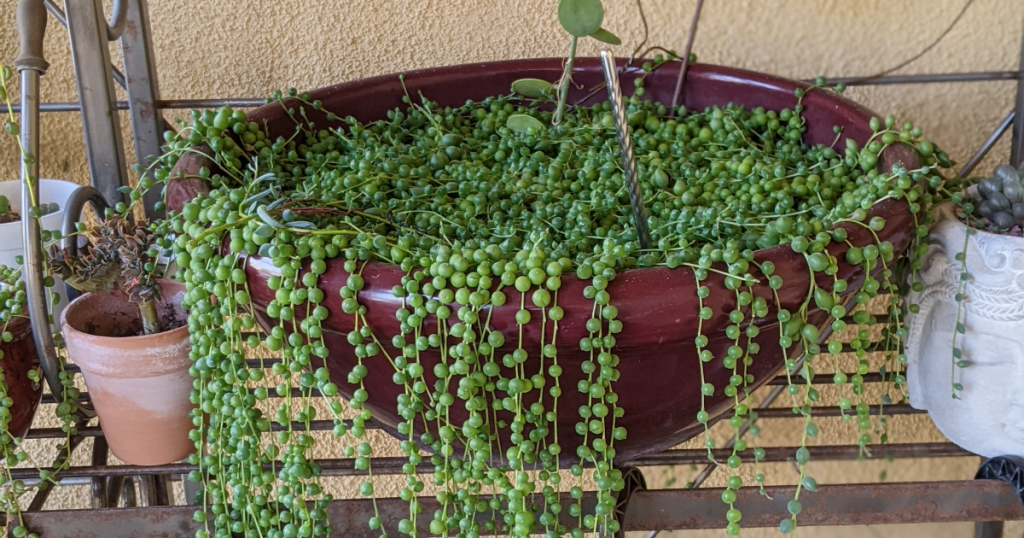
How to Propagate String of Pearls Step-by-Step:
- Take stem cuttings that are about 3-4 inches long. Cut the stems using pruning shears. Make sure that each cutting has at least three sets of leaves.
- Let the cuttings dry for a day or two. This will allow the cut ends to callus over and prevent rotting.
- Fill a small pot with potting mix and make a hole in the center.
- Insert the cut end into the hole in the potting mix and gently press the soil around the stem.
- Coil the string on top of the soil and secure them with pins if needed. Anywhere the stem is touching the soil is where roots will form.
- Place the pot in a bright, indirect light. Avoid direct sunlight as it may burn the cuttings. Keep the soil slightly moist, but not too wet.
- After a few weeks, the cuttings should have developed roots and can be transplanted to their own pots.
Care for the Cuttings
Once the cuttings have been potted up, it’s important to care for them properly to ensure they take root and grow successfully. Here are some tips to follow:
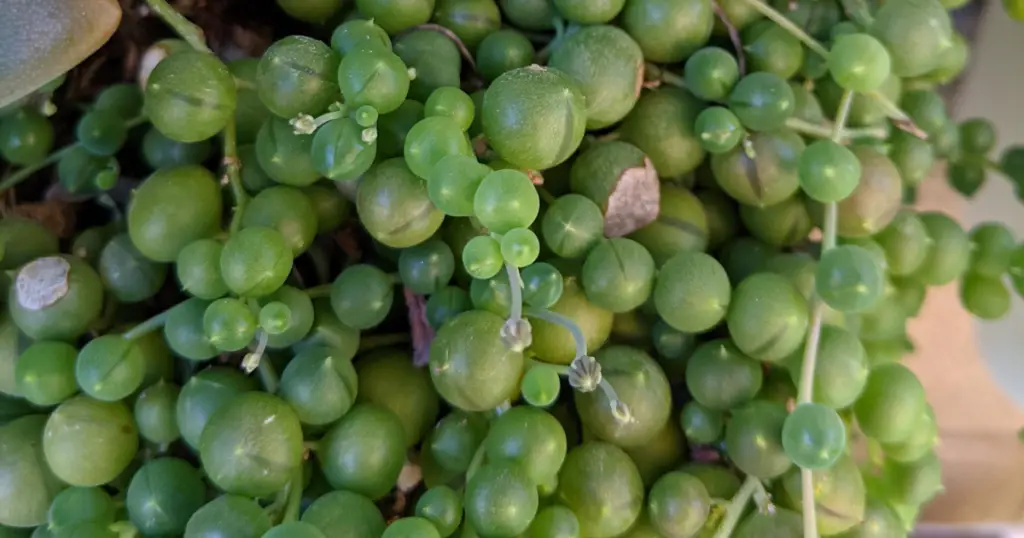
Provide indirect light
String of pearls cuttings prefer bright, indirect light. Direct sunlight can scorch the leaves and dry out the soil too quickly.
Keep the temperature warm
String of pearls cuttings prefer warm temperatures, ideally between 60-75°F (15-24°C). Avoid exposing them to temperatures below 50°F (10°C), as this can cause damage to the leaves and slow down the rooting process.
Repot the Cuttings
After a few months, you should start to see new growth from the cuttings, which indicates that they have taken root. At this point, it’s a good idea to repot the cuttings into their own separate containers. Here’s how to do it:
Choose a well-draining pot
Select a pot with drainage holes to prevent water from accumulating and causing root rot. Use a well-draining soil mix, such as a cactus mix or a mix of potting soil and perlite.
Gently remove the cuttings from the original pot
Carefully remove the cuttings from the original pot, taking care not to damage the new roots.
Plant the cuttings in the new pot
Plant the cuttings in the center of the new pot, making sure that the roots are covered with soil. Water the cuttings lightly, then place the pot in bright, indirect light.
You might also like: Efflorescence on Terracotta Pots: What It Is and 4 Simple Ways to Prevent It
Propagating string of pearls is a great way to expand your collection of these unique and interesting plants. By following the steps outlined above, you can successfully propagate string of pearls and enjoy the beauty of this plant in multiple locations throughout your home or garden.
Common Name: ‘String of Pearls’ or ‘String of Beads’
Hardy to USDA Zone: 10a- Size: Over 12″
- Foliage: Green
- Flower: White
Propagation: Stem cuttings, seed
Light: Dappled sun, bright shade
Water: Drench & Dry
Soil: Gritty, mostly inorganic, quickly draining- Origin: South Africa
Toxic: YES
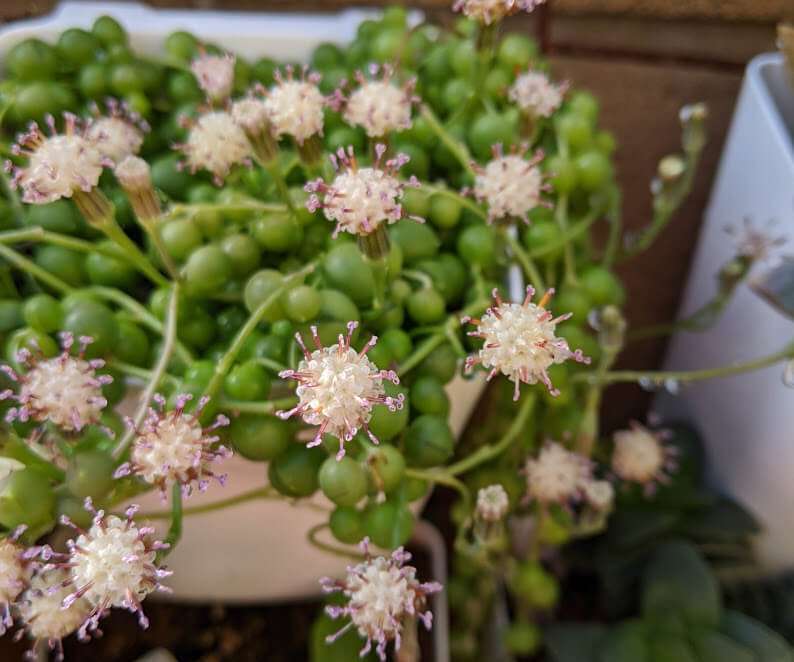
Senecio rowleyanus is most commonly known as ‘String of Pearls’ for its almost perfectly spherical leaves. It is dormant in the summer, but grows quickly when temperatures cool down in the fall and winter.
The shape of its leaves maximize water content while minimizing surface exposure to light. For this reason, they can go for long periods without water. The most common problem people have with ‘String of Pearls’ is overwatering. Wait until the pearls lose their shine, start to look dull and shrink due to a lack of water. You’ll notice an indent in the pearls when it is time to water.
Senecio rowleyanus ‘String of Pearls’ loves bright light, but not direct sunlight. Sun stress turns the pearls a purplish-brown color. It usually blooms in the summer and when it does, be sure to smell the flowers. They smell like cinnamon!
Senecio is a genus of plants that includes both succulent and non-succulent species. Some examples of succulent senecio species include Senecio rowleyanus, commonly known as string of pearls, and Senecio mandraliscae, also known as blue chalksticks. These plants are prized for their attractive, fleshy leaves and their ability to store water in their leaves and stems, making them well-suited to dry climates and growing conditions.
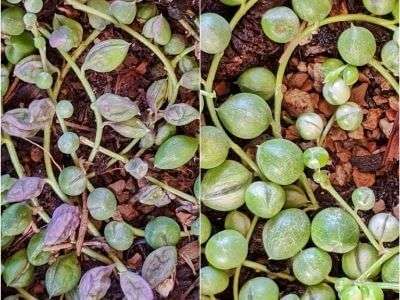
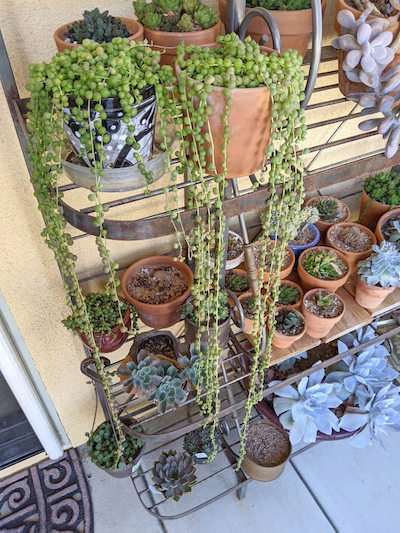
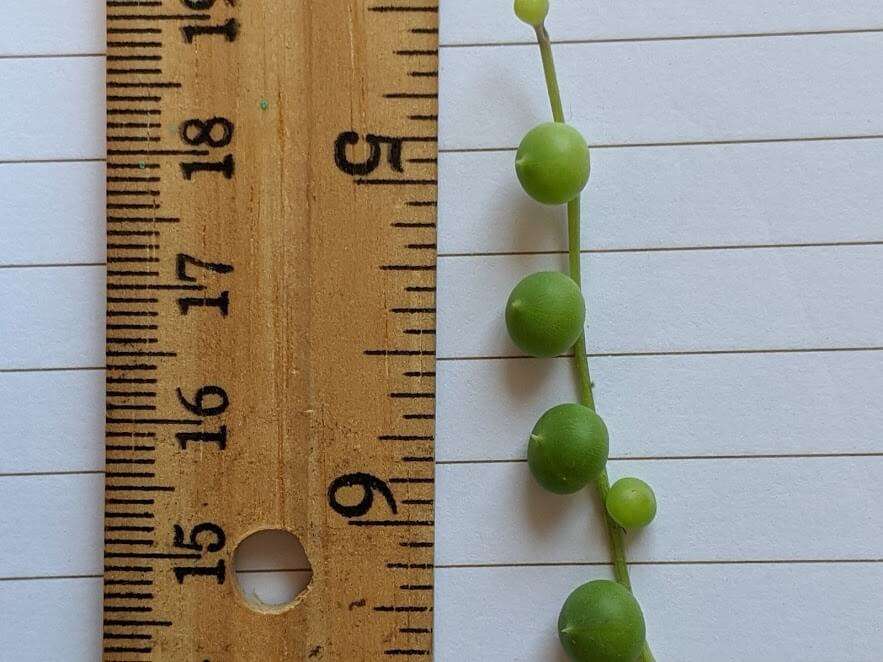
As with any plant, the key to success is providing the right growing conditions and paying attention to the needs of your plants. Happy gardening!

